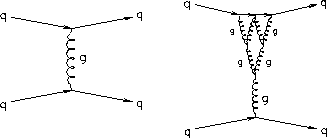If quarks are ``real'' particles and not just a cute mnemonic metaphor
for some esoteric mathematics,![]() we ought to be able to ``see'' one in a bubble chamber or other
device ``watching'' a high energy scattering event. Unfortunately,
this can never be. The reason is intriguing.
we ought to be able to ``see'' one in a bubble chamber or other
device ``watching'' a high energy scattering event. Unfortunately,
this can never be. The reason is intriguing.

Figure:
Left:  in first order --- two quarks exchange a
single gluon at close range.
Right: if the two quarks get too far apart, the original
gluon gets an chance to branch into several gluons,
strengthening the attractive force.
in first order --- two quarks exchange a
single gluon at close range.
Right: if the two quarks get too far apart, the original
gluon gets an chance to branch into several gluons,
strengthening the attractive force.
The `` superstrong'' force between quarks is transmitted by
the exchange of gluons [a nice descriptive name, for once!]
which are massless, like photons, but have one trick up their sleeves
that photons don't: they can ``branch'' (one gluon coupling to two
gluons, and so on) if given enough room. Thus, while the electromagnetic
force drops off as  , the superstrong or
, the superstrong or  force
actually increases with increasing distance between the two
quarks! Once the distance gets big enough --- as in a high-energy
collision --- the energy stored in the gluon field is so intense
that quark-antiquark pairs are created out of the vacuum
between the quarks and the original quark grabs the new antiquark
to become a meson, while the new quark takes the place of the
old one in the hadron that has collided.
force
actually increases with increasing distance between the two
quarks! Once the distance gets big enough --- as in a high-energy
collision --- the energy stored in the gluon field is so intense
that quark-antiquark pairs are created out of the vacuum
between the quarks and the original quark grabs the new antiquark
to become a meson, while the new quark takes the place of the
old one in the hadron that has collided.
Thus, try as we might, we can never create a free quark. We can never ``see'' these ubiquitous particles that make up everything around us except leptons. This is very frustrating and for years led many particle physicists to insist that quarks were just figments of theorists' imaginations. But of course the paradigm works too well to be abandoned and the skeptics have by now pretty much given up.